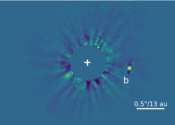Direct image of newly discovered brown dwarf captured
Astronomers using two Maunakea Observatories—Subaru Telescope and W. M. Keck Observatory—have discovered a key benchmark brown dwarf orbiting a sun-like star just 86 light-years from Earth that provides a key reference ...









